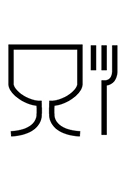

| EN388 MECHANICAL PROTECTION (The numbers below the symbol indicate the performance level of categories A to F) |
||||||||
| Performance Levels | 1 | 2 | 3 | 4 | 5 |
|||
| A. Abrasion resistance (cycles) | 100 | 500 | 2000 | 8000 | - | |||
| B. Blade cut resistance (index) | 1.2 | 2.5 | 5.0 | 10.0 | 20.0 | |||
| C. Tear resistance (newton) | 10 | 25 | 50 | 75 | - | |||
| D. Puncture resistance (newton) | 20 | 60 | 100 | 150 | - | |||
| E. Cut (TDM-100 test) |
A (Lowest >4.9 Newtons) |
B (5 - 9.9 Newtons) | - | |||||
| C (10 - 14.9 Newtowns) | D (15 - 21.9 Newtons) | - | ||||||
| E (22 - 29.9 Newtons) |
F (Highest >30 Newtons) | - | ||||||
| F. Impact protection | P = Passed or Blank/X = test not performed/applicable | |||||||
| EN374 CHEMICAL PROTECTION AND/OR MICRO-ORGANISMS | ||||
| Chemical Protection | ||||
 |
XYZ represents code letters for chemicals in this list: Type A: Breakthrough time >30 minutes for at least 6 chemicals. Type B: Breakthrough time >30 minutes for at least 3 chemicals. Type C: Breakthrough time >10 minutes for at least 1 chemical. |
A. Methanol B. Acetone C. Acetonitrile D. Dichloromethane E. Carbon disulphide F. Toluene |
G. Diethylamine H. Tetrahydrofurane I. Ethyl acetate J. n-Heptane K. Sodium hydroxide 40% L. Sulphuric acid 96% |
M. Nitric Acid 65% N. Acetic Acid 99% O. Ammonium Hydroxide 25% P. Hydrogen Peroxide 30% S. Hydrofluoric Acid 40% T. Formaldehyde 37% |
| Chemical resistance against chemicals of choice (AQL < 4) | Micro-organisms | |||
 |
The 'Low Chemical Resistant' pictogram is used for those gloves that do not achieve a breakthrough time of at least 30 minutes against at least three chemicals from the defined list, but which comply with the Penetration test. |
 |
The 'Micro-organism' pictogram is to be used when the glove offers protection against bacteria and fungi. If VIRUS appears below the pictogram, the glove offers protection against bacteria, fungi and viruses. | |
| EN407 HEAT PROTECTION (The numbers below the symbol indicate the performance level of categories A to F) | |||||
 |
Performance levels | 1 | 2 | 3 | 4 |
| A. Burning behaviour (after flame and after glowtime) | < 20 secs no requirement |
< 10 secs < 120 secs |
< 3 secs < 25 secs |
< 2 secs < 5 secs |
|
| B. Contact heat (contact temperature and threshold time) | 100°C > 15 secs |
250°C > 15 secs |
350°C > 15 secs |
500°C > 15 secs |
|
| C. Convective hear (heat transfer delay) | > 4 secs | > 7 secs | > 10 secs | > 18 secs | |
| D. Radiant heat (heat transfer delay) | > 7 secs | > 20 secs | > 50 secs | > 95 secs | |
| E. Small drops molten metal (number drops) | > 10 drops | > 15 drops | > 25 drops | > 35 drops | |
| F. Large quantity molten metal (mass) | 30g | 60g | 120g | 200g | |
| EN511 COLD PROTECTION (The numbers below the symbol indicate the performance level of categories A to C) | ||||||
 |
Performance levels | 0 | 1 | 2 | 3 | 4 |
| A. Convective cold Thermal insulation ITR in m². oC/W |
|<0.10 | 0.10<|<0.15 | 0.15<|<0.22 | 0.22<|<0.30 | 0.30<| | |
| B. Contact cold Thermal resistance R in m². oC/W |
R<0.025 | 0.025<R<0.050 | 0.050<R<0.100 | 0.100<R<0.150 | 0.150<R | |
| C. Water penetration test | Fail | Pass | - | - | - | |
Note: 0 is the lowest rating while 4 is the highest
| OTHER STANDARDS & DEFINITIONS | |
 |
The international symbol for 'food safe' identifies that the material used in the product is safe for food contact, used in North America, Europe and parts of Asia. |
| EN 455 (Parts 1, 2, 3, 4) |
This standard specifies requirements and tests for single use medical gloves for medical purpose. This includes tests to assess the freedom from holes which is based on a penetration resistance test (similar to EN 374 Part 2), tests to assess the dimensions of the gloves and the mechanical strength of its materials, both before and after an ageing process. |
| ASTM D3578 | Standard specification for dimensions, tolerances and physical requirements for rubber examination gloves. |
| ASTM D6319 | Standard specification for dimensions, tolerances and physical requirements for nitrile examination gloves. |
Disclaimer:
Gloves that provide cut or puncture resistance are not cut or puncture proof and do not completely eliminate the potential for cuts or punctures. Cut resistant gloves are not intended to provide protection against powered blades, serrated or other sharp or rotating equipment. Gloves that provide abrasion resistance do not completely eliminate the potential for abrasion-related injuries. Gloves that provide chemical resistance do not completely eliminate the potential for injury due to chemical exposure. It is the responsibility of companies to undertake their own testing and research to ensure that protection equipment is suitable for a particular application and their specific work environment.